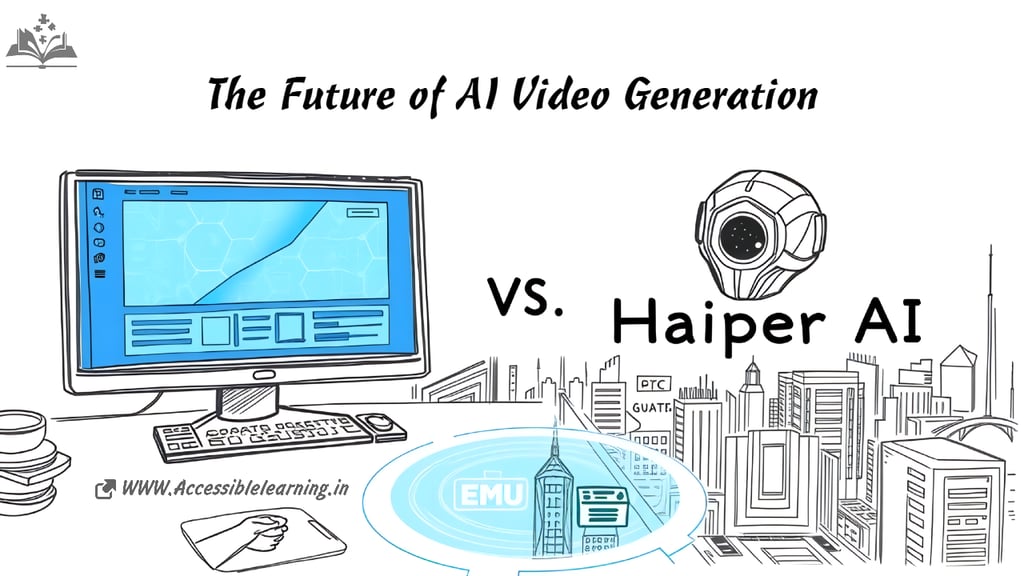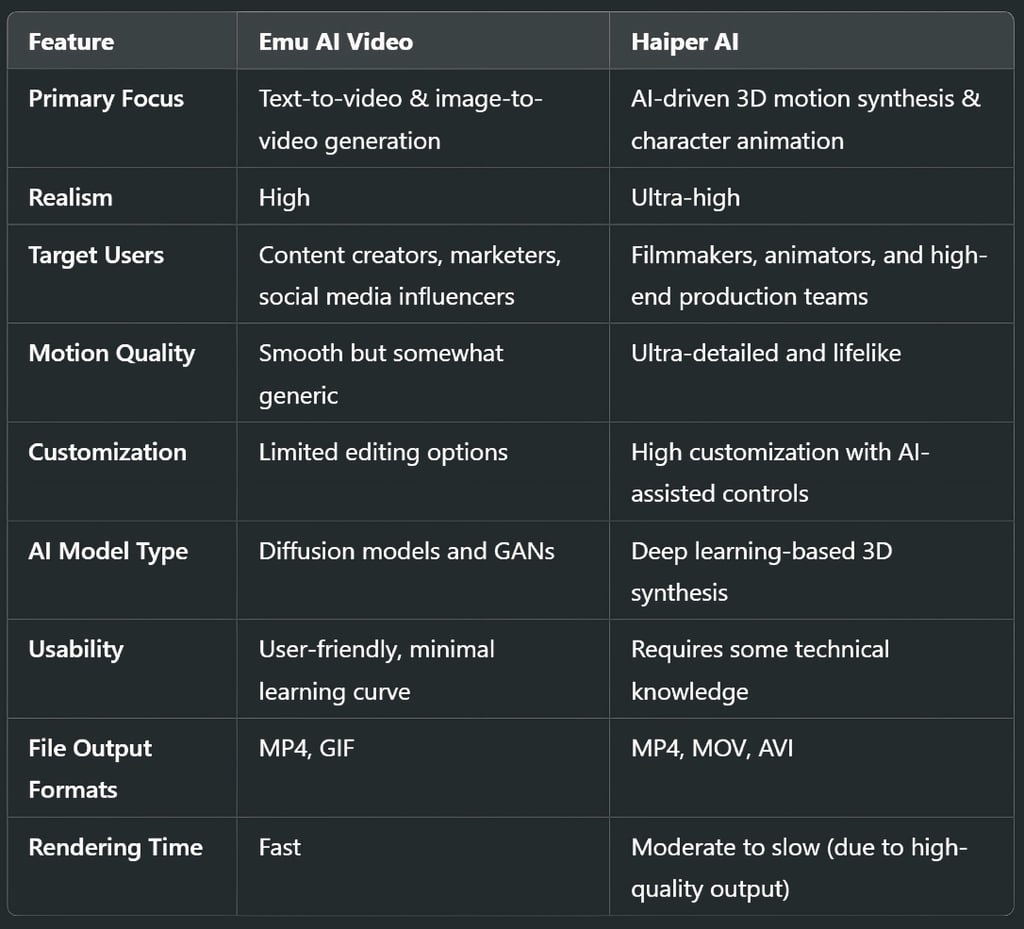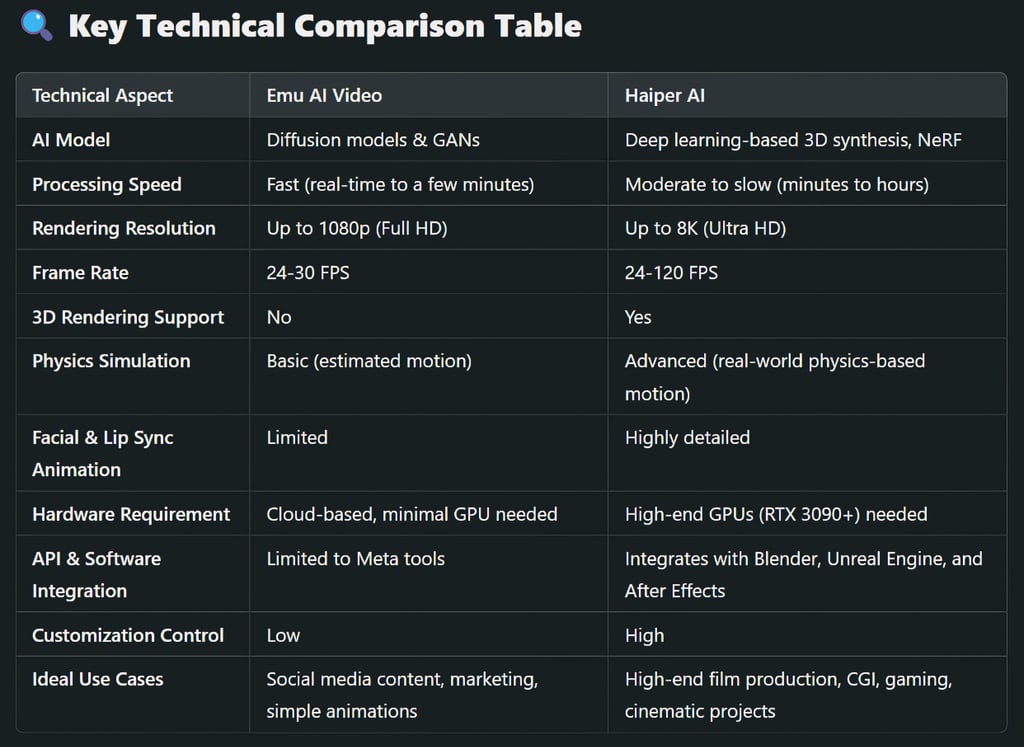
Emu AI Video vs Haiper AI: Which AI Tool Creates Better Videos?
Emu AI Video and Haiper AI are two leading AI-powered video generation tools, each catering to different needs—from social media content to high-end cinematic productions. This in-depth comparison explores their features, realism, customization, rendering speeds, and ideal use cases, helping you choose the best AI video tool for your projects.
AI ART TOOLSARTIST/CREATIVITYEDITOR/TOOLSAI/FUTURE
Sachin K Chaurasiya
3/20/20254 min read


The AI video generation landscape is evolving rapidly, with Emu AI Video and Haiper AI emerging as two promising contenders. Both platforms leverage artificial intelligence to transform text, images, and motion inputs into high-quality video outputs. However, their approaches, capabilities, and ideal use cases differ significantly. In this detailed comparison, we will explore the strengths and weaknesses of both, helping you determine which AI video tool suits your needs best.
What is Emu AI Video?
Emu AI Video is an advanced AI-powered video generation model developed by Meta. It utilizes deep learning techniques, including generative adversarial networks (GANs) and diffusion models, to create ultra-realistic video content. Emu AI Video is known for its:
Text-to-video and image-to-video generation
High fidelity and smooth animation
Ability to create realistic human motion
Seamless integration with Meta’s AI ecosystem
Support for various content styles, including cinematic, animated, and stylized outputs
AI-powered enhancement tools for post-processing
Emu AI Video aims to empower content creators by making video production more accessible, removing the need for complex software or manual editing.
Strengths
Fast Processing Speed: Utilizes diffusion models for quick video generation.
Beginner-Friendly: Simple UI with minimal learning curve.
Text-to-Video & Image-to-Video Capabilities: Converts static inputs into dynamic video efficiently.
Integration with Meta's Ecosystem: Seamless sharing on Facebook, Instagram, and WhatsApp.
Multiple Content Styles: Supports cinematic, stylized, and animated effects.
AI-Powered Enhancements: Automatic improvements in lighting, transitions, and motion.
Weaknesses
Limited Customization: Less control over fine details like motion physics and lighting.
Generic Motion Outputs: Lacks the ultra-detailed realism of physics-based rendering.
Lower Realism in Character Animation: Faces and body movements can appear slightly artificial.
Fewer Export Options: Supports only standard formats like MP4 and GIF.
What is Haiper AI?
Haiper AI is another innovative AI-driven video generation platform that focuses on producing ultra-high-definition, hyper-realistic motion videos. Unlike traditional AI video generators, Haiper AI specializes in:
AI-enhanced motion graphics and animation
3D video synthesis with fine-tuned realism
AI-assisted character animation
Scalability for large-scale video production
Advanced physics-based simulations for dynamic motion
AI-driven facial expressions and body language generation
Haiper AI is designed for filmmakers, marketers, and creative professionals who require cutting-edge visuals with minimal manual intervention.
Strengths
Ultra-Realistic Animation: Delivers hyper-detailed motion and lifelike character expressions.
Advanced 3D Rendering: Ideal for high-end productions, including gaming and films.
AI-Assisted Physics & Motion Graphics: Realistic environmental interactions, shadows, and reflections.
High Customization: Users can fine-tune motion, lighting, and character expressions.
Professional-Grade Outputs: Supports industry-standard software like Adobe After Effects and Blender.
Wide Format Support: Outputs in MP4, MOV, AVI, and other high-resolution formats.
Weaknesses
Longer Rendering Time: High-quality outputs require more processing power.
Steeper Learning Curve: Requires technical knowledge for optimal use.
Not Ideal for Quick Content: Best suited for high-end production rather than fast social media videos.
Limited Direct Social Media Integration: Unlike Emu AI Video, it lacks built-in Meta platform sharing.




Performance & Quality Comparison
Video Realism & Motion Smoothness
While both tools offer AI-powered motion synthesis, Haiper AI takes the lead in realism, especially for human and object motion. Its deep learning algorithms ensure that AI-generated characters move fluidly, mimicking real-world physics. Emu AI Video, on the other hand, is more focused on text and image conversion, leading to slightly less refined motion but excellent general-purpose videos.
Customization & User Control
Haiper AI provides advanced customization options, allowing users to fine-tune lighting, motion details, object interactions, and even environmental effects like shadows and reflections. This makes it ideal for high-end productions. Emu AI Video, while easy to use, lacks extensive customization options, making it better suited for quick content creation rather than professional-grade projects.
AI Model & Processing Speed
Both tools utilize cutting-edge AI models, but Emu AI Video processes videos faster due to its lightweight diffusion model. Haiper AI, with its deep learning and 3D rendering capabilities, takes longer but offers superior output quality. The choice between the two depends on whether speed or quality is more critical for your project.
Integration with Other Tools
Emu AI Video integrates seamlessly with Meta’s ecosystem, including Instagram, Facebook, and WhatsApp, allowing for direct sharing and editing within Meta’s suite of apps.
Haiper AI provides compatibility with professional-grade software like Adobe After Effects, Blender, and Unreal Engine, making it more suitable for high-end film production and gaming applications.
Which One Should You Choose?
Choose Emu AI Video if you need:
Quick and easy AI video generation
Social media content, marketing videos, or simple animations
A beginner-friendly tool with minimal effort
Faster processing for high-volume content creation
Choose Haiper AI if you need:
High-quality, professional animations and motion graphics
Advanced 3D rendering and hyper-realistic videos
A tool for film production, gaming, or complex visuals
More control over visual elements, lighting, and physics-based motion
Both Emu AI Video and Haiper AI push the boundaries of AI video generation, but they cater to different audiences. Emu AI Video is excellent for creators looking for a straightforward, fast, and efficient video-making tool, while Haiper AI is tailored for professionals who require top-tier realism and control.
As AI continues to evolve, we can expect both platforms to refine their offerings, making high-quality AI-generated video content more accessible than ever. Whether you’re a casual creator or a professional filmmaker, the right choice depends on your specific needs and creative ambitions.
Future Potential of AI Video Generation
Looking ahead, AI video tools like Emu AI Video and Haiper AI are expected to become even more sophisticated. Potential advancements include:
Real-time AI video editing with interactive customization
AI-generated voice synchronization with lip movements
Enhanced deepfake prevention to ensure ethical AI use
Higher frame rate rendering for even smoother motion
With these innovations, AI video generation is set to revolutionize the industry, making professional-quality videos accessible to all.
Subscribe To Our Newsletter
All © Copyright reserved by Accessible-Learning Hub
| Terms & Conditions
Knowledge is power. Learn with Us. 📚


